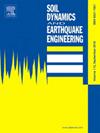Fuzzy analytical hierarchy process and component importance measures for selection optimal intensity measures and development fragility curves in bridges
IF 4.2
2区 工程技术
Q1 ENGINEERING, GEOLOGICAL
引用次数: 0
Abstract
The process of selecting optimal intensity measures (IM) in complex systems is a multi-criteria decision-making (MCDM) approach. However, previous studies mainly assumed constant weights for performance metrics and neglected the importance of various components. To overcome these challenges, a framework that was formulated based on the order preference by similarity to the ideal solution (TOPSIS), using the fuzzy analytical hierarchy process (FAHP) and component intensity measures (CIMs) is proposed. 3200 multi-span continuous concrete I-girder (MSCC-IG) and multi-span simply supported concrete I-girder (MSSSC-IG) bridges are randomly paired with a suit of input motion through probabilistic seismic demand analysis (PSDA). FAHP reveals that among different performance metrics proficiency and practicality have the highest and the lowest weight in the selection of optimal IM, respectively. The findings of the proposed framework show that the foundation, which has the lowest CIMs, has an insignificant impact on the selection of optimal IM in bridges. Moreover, the Sa(1,2), which is a summation of 0.80 and 0.20 spectral acceleration in the first and second modes of vibration in bridges, respectively, is the ideal IM in the majority of components of bridges. Fragility outcomes of this study reveal that the vulnerability of MSSSC-IG bridges is higher compared to MSCC-IG bridges at the system level.
模糊层次分析法和构件重要度法选择桥梁最优强度指标和发展易损性曲线
复杂系统中最优强度测度的选择是一种多准则决策方法。然而,以往的研究主要是对绩效指标假设恒定的权重,忽略了各组成部分的重要性。为了克服这些挑战,利用模糊层次分析法(FAHP)和部件强度度量(CIMs),提出了一个基于理想解相似性排序偏好(TOPSIS)的框架。通过概率地震需求分析(PSDA),对3200座多跨连续混凝土工字梁(MSCC-IG)和多跨简支混凝土工字梁(MSSSC-IG)桥梁进行了随机配对。层次分析法表明,在不同的绩效指标中,熟练度和实用性在最优IM的选择中分别具有最高和最低的权重。该框架的研究结果表明,具有最低cim的基础对桥梁中最优IM的选择影响不显著。此外,Sa(1,2)在桥梁的第一振型和第二振型中分别为0.80和0.20谱加速度之和,是桥梁大多数部件的理想IM。本研究的脆弱性结果表明,MSSSC-IG桥梁在系统层面的脆弱性高于MSSSC-IG桥梁。
本文章由计算机程序翻译,如有差异,请以英文原文为准。
求助全文
约1分钟内获得全文
求助全文
来源期刊

Soil Dynamics and Earthquake Engineering
工程技术-地球科学综合
CiteScore
7.50
自引率
15.00%
发文量
446
审稿时长
8 months
期刊介绍:
The journal aims to encourage and enhance the role of mechanics and other disciplines as they relate to earthquake engineering by providing opportunities for the publication of the work of applied mathematicians, engineers and other applied scientists involved in solving problems closely related to the field of earthquake engineering and geotechnical earthquake engineering.
Emphasis is placed on new concepts and techniques, but case histories will also be published if they enhance the presentation and understanding of new technical concepts.
 求助内容:
求助内容: 应助结果提醒方式:
应助结果提醒方式:


